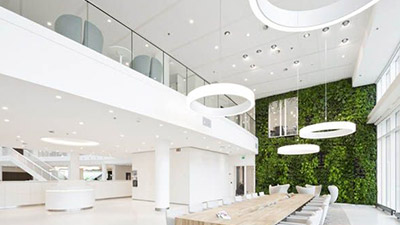
- Homeowners
- Professionals
- Products
- Back
- PlasterBoards
- Metal Framing & Accessories
- Jointing and Finishing
- Gypsum Plasters
- Ceiling Tiles
By material Type
By Category
- Resources
- About
- Careers
- FAQ's

Date: 30 June 2020
Sudeep Kolte, VP, sales & marketing, Saint Gobain India – Gyproc business, believes in adopting modern methods of construction
Rapid infrastructure development, including construction of roads, bridges, power plants, etc. have not only helped boost manufacturing, services and trade, but also attracted substantial investments, further making us one of the fastest-growing economies of the world. India was projected to become the third largest construction market globally by 2022, with a plan to spend US$ 1.4 trillion on infrastructure during 2019-23 focused at sustainable development. The recent pandemic, however, forced the country to a slowdown, causing economic activities to tailspin and rethink infrastructure. Although some sectors managed to sustain efforts and performance in the most unprecedented times, even from remote locations, the modern infrastructure wasn’t fully equipped to adapt itself to the disruptions caused by the pandemic.
While India can definitely capitalize on the current disruption to accelerate the inevitable shift to a more resilient, regenerative and technologically advanced ecosystem, the question that lies ahead is that of sustainability- financial, ecological and social. Alongside this, it will also be imperative for the industries to gain momentum and set new trends in designs that prioritize space, sanitation measures and the flexibility of workplace ecosystem.
Public health and safety
Right from basic infrastructure needs like well-paved roads, drains, sewage, clean drinking water, good public buildings and housing, to larger ecosystem challenges like land, labor and capital, the new phase of development will reimagine infrastructure in response to an increased understanding of public health and safety. Meaning- efficient project planning, adoption of renewable and eco-friendly materials, optimum use of technology, balanced manual labor, increased on-site safety and new designs. For instance, labor-intensive and field-based industries like construction and manufacturing will not only have to revisit working norms to balance their day-to-day functions, but also adopt sustainable building materials and technology that enable seamless construction cycle and elemental safety. Furthermore, the move to the greener materials will mean improved indoor air quality, higher ventilation, reduced illness and water and energy efficiency. Not only that, the practical change in use of large public spaces like offices, airports, hospitals and gyms, and private spaces like homes will also mean demand for better social infrastructure.
Beyond this, public spaces will also see a move towards automation to alleviate contagion, especially within urban settings. Development and implementation of all types of contact-less technology across doors, elevators, IOT within travel and stay, and advanced check-in and security, will gain avenues. Use of anti-bacterial interior elements and standard healthcare applications will likely see an upgrade outside just healthcare facilities.
Moving toward sustainable construction techniques
With growing concerns of climate change there is tremendous pressure across industries to reduce the impact on the environment, especially by sectors that utilize vast amount of natural resources like infrastructure and construction. ‘Sustainability’ and ‘sustainable practices’ have become buzzwords in current times, as a new approach to improving quality of living, however, there are few who completely understand its potential. The construction sector, for example, is responsible for 40% of all energy-related carbon dioxide (CO2) emissions; and this is just from the construction and operation of buildings. The move to sustainable methods will require rethinking resources and processes right from planning, design and construction to maintenance and renovation to create more resilient structures. Sustainable practices in construction will help promote efficient use of resources, reduce solid waste, minimize carbon emission and cut down costs. Processes and technologies that are resource efficient and environmentally friendly, like using materials with lower embodied energy and reduced carbon footprint, will see greater adoption and viability as construction techniques evolve to cater to a post pandemic world. With respect to public benefits, it will mean elevated livability quotient and improved community health.
Anecdotally, it is often said that sustainability will mean faster progression and attainable resilience. However, the pace at which this shift is now a need, the recourse to technology will be more critical than ever.
Embracing technology
"Artificial intelligence (AI), advanced data analytics, 5G, prefabrication, modular construction, new materials, renewable energy technology, 3D printing, fintech and modern Building Information Modeling (BIM) software are just a few of the innovations currently changing the global infrastructure landscape."
According to World Economic Forum, the infrastructure industry has been comparatively slow in embracing and utilizing technological innovations to the fullest. In the last decade, on the contrary, we saw infra-tech successfully demonstrate tangible outcomes and prove how it can be a great enabler. Integration of technologies into the existing processes- design, construction and operations- can significantly help lower the cost, while improving functionality. Artificial intelligence (AI), advanced data analytics, 5G, prefabrication, modular construction, new materials, renewable energy technology, 3D printing, fintech and modern Building Information Modeling (BIM) software are just a few of the innovations currently changing the global infrastructure landscape. When applied in an effective manner, they help decrease project cost, compress construction time, reduce community disruption, minimize environmental harm and increase safety. Moreover, the focus should be on building holistic network of integrated systems and applications that effectively interact with each other, allowing stakeholders to map, review and improvise project cycle almost real-time.
The shift that industries are now gearing towards focus on adoption of sustainable technologies that are non-reliant on manual labor and scarcely affected by situations like COVID-19. Solutions for which will gradually pave the way. However, in the long run, climate change will continue to be a larger issue for the government. This pivotal move to sustainability will therefore need the government to play a role in ensuring that the backbone of the economy is sustainable and future resilient with continued policy and investment support.